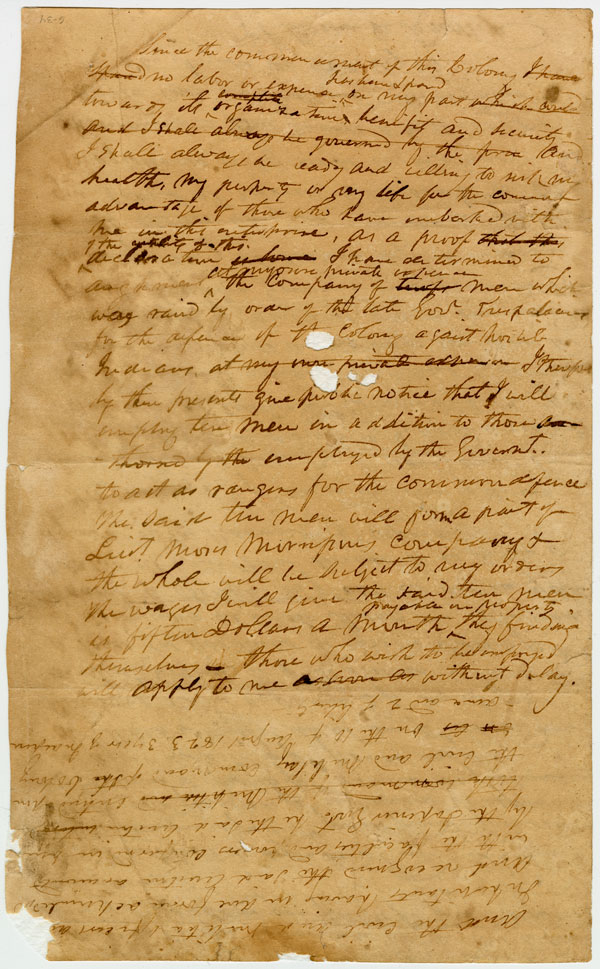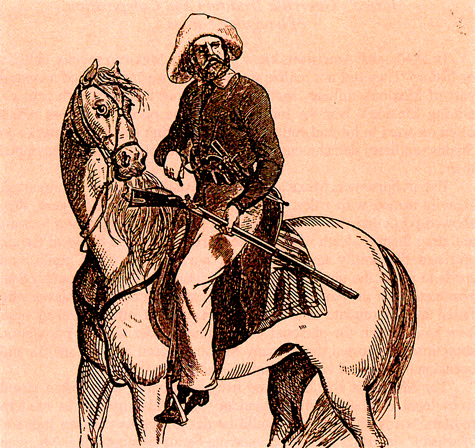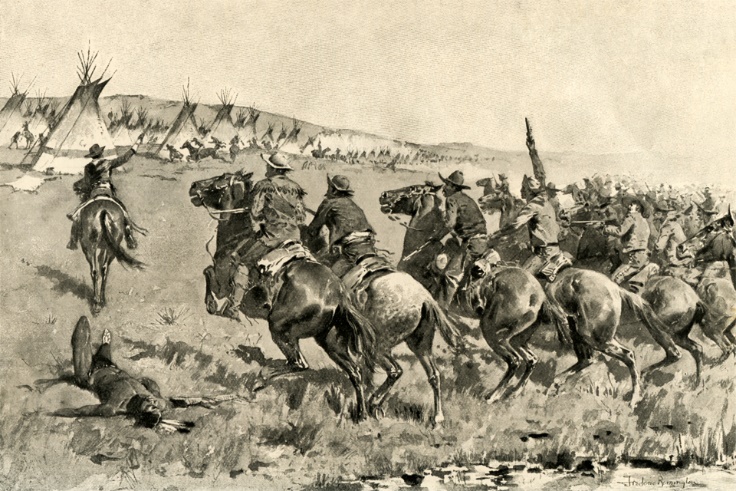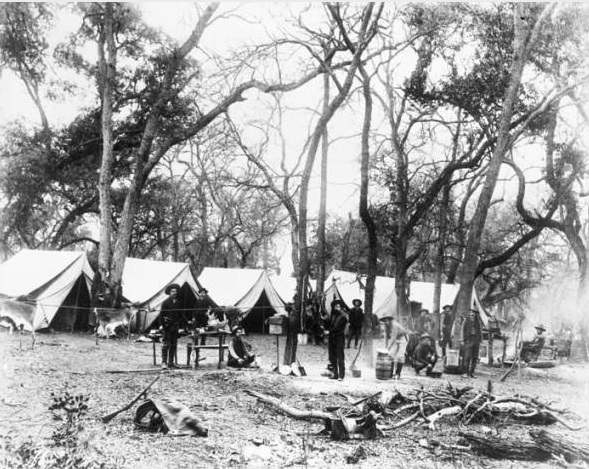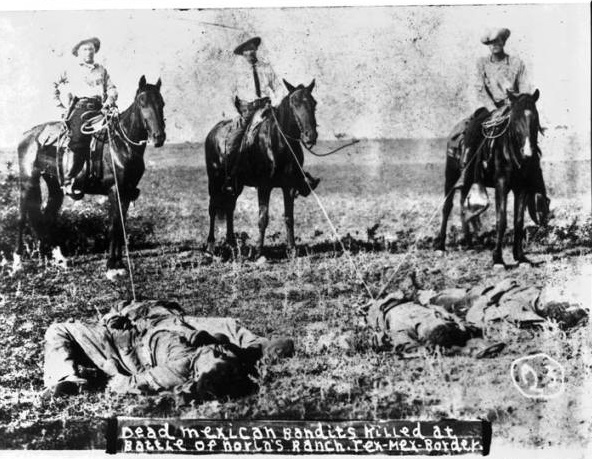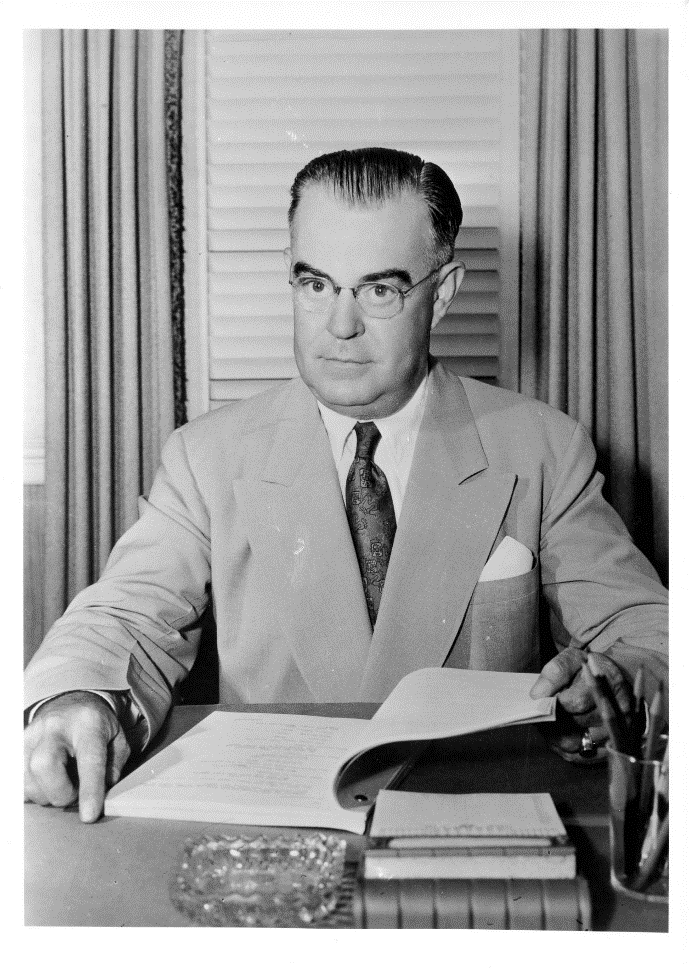Texas Rangers
The history of the Texas Rangers is as complicated as Texas history itself
The history of the Texas Rangers spans nearly 200 years. Thousands of Rangers patrolled the frontier, fought in military battles, and arrested cattle rustlers. Their story contains heroic acts of bravery, but also moments that challenge our idea of the Rangers as noble lawmen. They protected settlers and enforced laws, but also sometimes executed thieves without a trial, drove Native American tribes from their homelands, and some Rangers even lynched Mexicans and Mexican Americans along the Texas-Mexico border.
They were men who could not be stampeded. Colonel Homer T. Garrison, Jr.
“Rangers for the common defense”
In 1823, empresario Stephen F. Austin announced he would supplement the Mexican government’s militia patrols with his own force of ten men, whom he paid out of his own pocket. Thus, the Texas Rangers were born.
Unsatisfied with the protection the Mexican government provided, Stephen F. Austin created his own force of “rangers” to protect the men and women living in his colony. Austin tasked the Rangers with patrolling the roads and wilderness around the colony for “errant thieves united with Indians.” Many of the men who volunteered as Rangers lived in Austin’s colony and hoped their service would help protect their own families from attacks by American Indians. Some were also motivated by the desire to take revenge on American Indians for past raids.
During the Texas Revolution in 1836, the provisional government authorized the first official, government-sanctioned Ranger force to patrol the Texas frontier and protect settlers from raids by American Indians. Though this force was reorganized after Texas won its independence from Mexico, it continued to function in much the same way: groups of volunteers were organized as they were needed to patrol and protect the frontier, then disbanded when their specific missions were done.
Patrolling the Frontier
After the 1836 Texas Revolution, a wave of new settlers headed to Texas enticed by acres of land offered for little money. This increased settlement led to conflicts with American Indians who already occupied the territory and a renewed desire to send the Texas Rangers out on patrol.
To protect the new Texans, Ranger companies patrolled the frontier as well as the border with Mexico. It was during this time that John “Jack” Coffee Hays became the most famous Texas Ranger of the era. Fighting in some of the period’s most significant battles between Texans and American Indians, Hays quickly proved himself to be a strong leader, smart decision-maker, and fearless and brutal fighter. He rose up the ranks quickly and was soon leading Ranger companies on frontier patrols and in battles against American Indians.
Hays and the Texas Rangers also played a crucial role in securing the Texas-Mexico border during the 1840s. Agaton Quinones and Manuel Leal led groups of thieves who crossed the Rio Grande into Texas to rob travelers and rustle cattle, then fled back to Mexico to sell their stolen goods. These bandits operated under the protection of Mexican Captain Ignacio Garcia, who received a percentage of the profits. In response to the increasing number of attacks by Quinones’s and Leal’s men, Hays was given broad legal powers to track down the thieves and execute them without trial, which he did.
Each [Ranger] was armed with a rifle, a pistol, and a knife. With a Mexican blanket tied behind his saddle and small wallet in which he carried salt and ammunition and perhaps a little panola or parched corn, spiced and sweetened – a great allayer of thirst – and tobacco, he was equipped for a month. The little body of men, unencumbered by baggage wagons or pack trains, moved as lightly over the prairie as the Indians.
– John C. Caperton, author of “Sketch of Colonel John C. Hays, Texas Ranger”
Rangers as Soldiers
On December 29, 1845, Texas became part of the United States. The boundaries established led directly to a war with Mexico. Many current and former Rangers joined the fight.
Using the skills they had honed battling American Indians in Texas, the Rangers quickly made a name for themselves as bold fighters during the U.S.-Mexican War (1846-48). Their scouting and tracking skills also helped locate Mexican camps and guerilla fighters both during and after the war.
The Rangers’ prowess in battle was striking, and by the end of the war the words “Texas Ranger” evoked images of fierce fighters and expert trackers around the world. Some Mexicans even gave them the nickname “los diablos Tejanos”: the devil Texans. Unfortunately, the Rangers’ behavior in other areas would directly contradict their heroic battlefield reputation. After the Battle of Monterrey, one group of Rangers burned homes and killed as many as 100 civilians. Others stole whiskey and livestock from Mexican peasants. General Zachary Taylor said of the Rangers under his command, “There is scarcely a form of crime that has not been reported to me as committed by them.”
On the Offensive
With the U.S.-Mexican War behind them, the Rangers returned their focus to patrolling the frontier and tracking American Indians, this time with a more aggressive approach.
While the U.S. Army was officially in charge of keeping pioneers safe from attacks, there often weren’t enough soldiers to do the job effectively. In Texas, the Rangers filled in the gaps. As in the past, they patrolled the frontier, tracking down cattle thieves and pursuing American Indians who raided settlements. However, the Rangers also became more aggressive. Instead of responding to attacks after they happened, the Rangers began tracking tribes’ movements and going on the offensive.
In 1858, Texas Ranger John Salmon “Rip” Ford led 100 Rangers in a six-month campaign against Comanches. The Rangers were joined by an equal number of Tonkawas, who were traditionally enemies of Comanches. Working together, the Rangers and Tonkawas tracked Comanches with orders to punish them for the devastating raids they had conducted in Texas. Ford and his men pursued Comanche raiders to Indian Territory, crossed the border without permission, and then followed them to their permanent camp on Little Robe Creek. There the 200 fighters from Texas attacked 600 Comanches. Despite the uneven numbers, the Rangers’ superior firepower helped them win the battle. They killed 80 Comanches and lost only one of their own in the fight.
For many, the victory confirmed that Texas needed to rely on its Ranger force, and not the U.S. Army, for protection. Heedless of the lives lost, the Rangers’ new, more aggressive approach became standard practice for the next twenty years. It only ceased when the U.S. Army and the Texas Rangers forced nearly all American Indians out of Texas.
“Prairie Patrolmen”
The Texas Legislature approved the first permanent Ranger force in 1874. The Rangers and the U.S. Army drove the last Comanche and Kiowa out of the state soon after. In response, increasing numbers of settlers headed to the Texas frontier and created a new set of conflicts for the Rangers to police.
As more and more settlers poured into the frontier, conflicts inevitably arose. When tensions flared over the control of salt lakes near San Elizario in 1877, the Rangers were ordered to keep the peace. They did the same during the Fence Cutting Wars in the 1880s. In that conflict between ranchers who wanted to keep the range open and those who wanted to fence in their land and livestock, the Rangers tracked down and arrested accused fence cutters. The Rangers also assisted local law enforcement when the Sabine County Sheriff asked for help bringing in the Conner Gang, which was terrorizing the entire county. The Rangers became such a regular presence in rural areas that one publication nicknamed them “prairie patrolmen.”
As frontier towns grew in size they often created their own law enforcement agencies, eventually making the Rangers less necessary. By 1901, the Rangers’ usefulness was in question and state government shrank their numbers significantly.
Scandal on the Border
In the late 1910s, the role of Rangers in Texas was once again called into question as violence and scandal breached public trust and challenged their role as frontier heroes.
In 1915, tensions between Anglos and ethnic Mexicans along the Texas-Mexico border exploded into violence between the two groups. To restore order, Governor James Ferguson sent hundreds of Texas Rangers, including many brand new Special Rangers, to the border. To quell the violence, the Rangers implemented their own brand of lynch law against Mexicans and Tejanos. They executed at least 300 “suspected Mexicans” without any trial or conviction.
The Governor warned the Rangers to stop executing Mexicans, but the violence continued for several more years. Finally, in 1919, Representative José Tomas Canales of Brownsville requested an investigation of the Rangers before a joint committee. The joint committee found that the Rangers broke the law repeatedly and engaged in unwarranted violence. The appointments of almost all the Special Rangers were cancelled, several companies of regular Rangers disbanded, and both new and existing members were subjected to more stringent qualifications.
Toward Professionalization
Under the new leadership of Captains William L. Wright, Thomas R. Hickman, and Frank Hamer, the Rangers reformed and performed as a more professional force in the 1920s. During this time they returned to their law enforcement duties, patrolling for smugglers and cattle rustlers on the border.
In 1932, just as their star was on the rise again, the Rangers made a major political miscalculation that had devastating consequences. The Rangers backed incumbent governor Ross Sterling against Miriam “Ma” Ferguson. When Ferguson was elected, she fired every Ranger on the force for supporting her opponent. The Rangers had to rebuild their ranks from scratch. The new recruits weren’t yet up to the task, and Texas experienced a new era of lawlessness throughout the 1930s.
Nevertheless, the Rangers continued to professionalize their ranks. In 1935, the Rangers moved under the Texas Department of Public Safety, making them just one part of a larger law enforcement agency. They became the detective arm of the Department of Public Safety, and uniformed law enforcement duties were assigned to Highway Patrol officers.
At the same time the Rangers were moving away from their past as frontier lawmen, Hollywood elevated the frontier Ranger persona to new heights with The Lone Ranger television show in 1949. The series, followed by several films, created a new popular image of the Rangers as noble lawmen assisting those in need and meting out justice. This romanticized version of the Rangers came to define the Rangers and overshadow their previous misdeeds.
The Story Continues
Over nearly 200 years, the Rangers have transformed from a small militia protecting Stephen F. Austin’s colony to a corps of frontier lawmen who sometimes crossed the line between law enforcement and law breaking, and finally into modern-day Texas’s official state police force. Today, they investigate some of the state’s most serious crimes and difficult cases and carry on the legacy of the original Rangers, who sought to protect their friends and family from harm.
Texas Rangers Timeline
The Mexican territory of Tejas was opened to settlers on the conditions that they become Mexican citizens, learn Spanish and adopt the Catholic faith. Moses Austin, a founder of America's lead industry, obtained government permission to bring colonists to the territory. He died before the "Texas Venture" began and his son, Stephen, led 300 families on the journey to establish new colonies along the Brazos, Colorado and San Bernard Rivers.
The Mexican government advised Stephen F. Austin that it would not provide resources to administer or defend the fledgling Tejas colonies. Austin hired ten men to "act as rangers for the common defense" against Indian raids. With that, the legend of the Texas Rangers began.
The provisional Texas government passed a resolution officially creating a corps of over 50 rangers. These Rangers engaged in many skirmishes with American Indians and often joined with the Texian Army in fighting against Mexican troops in what became the opening battles of the Texas Revolution.
The Gonzales Ranging Company answered William B. Travis' impassioned letter asking for reinforcements to defend the Alamo. Thirty-two Rangers reached the fort on March 1. On March 6, all 32 Rangers died. This single troop loss accounted for 20% of all Alamo battle losses. These Rangers are now known in history as the "Immortal 32."
The Texas Legislature passed an act authorizing Rangers to employ the services of "friendly" American Indian tribes as scouts and spies. Flacco, a Lipan Apache chief, served under Ranger John (Jack) Coffee Hays in 1841 and 1842. Hays later credited Flacco with saving his life in more than one battle with the Comanches.
Republic of Texas President Mirabeau B. Lamar ordered the expulsion or extermination of all American Indian tribes. In the Battle of the Neches, near present-day Tyler, Cherokees were defeated in their attempt to retain land granted to them by a previous state treaty. Cherokee Chief Bowles died clutching a sword given to him by his close friend, Sam Houston.
Courtesy Texas State Library and Archives Commission
President Lamar ordered the Rangers to attack Comanche villages in his campaign to drive American Indians out of Texas. War chiefs agreed to peace negotiations with the Rangers at Council House in San Antonio. At the talks, the Comanches entered with an injured hostage and demanded more money for the remaining hostages. Soon bullets and arrows flew. Six Texans and many Comanche war chiefs, women, and children died. The stage was set for the Battle of Plum Creek.
John (Jack) Coffee Hays led a company of Rangers toward Plum Creek. Word had spread of raiding Comanches seeking retribution for the Council House massacre. The Comanches reached Kelly Springs where their war chief, wearing a stovepipe hat and carrying a lady's parasol taken from a Linnville warehouse, was killed immediately. Fierce fighting continued along the San Marcos River with 150 Comanches killed.
painting by Lee Herring
In 1836, the Republic of Texas voted in favor of annexation by the United States, but the U.S. wasn't interested because of concerns over the Republic's pro-slavery stance and an impending war with Mexico. By 1843, with the threat of British involvement in the Texas issue, U.S. President John Tyler proposed annexation. Texas drew up a state constitution in October 1845 and was admitted as the 28th U.S. state by the end of the year.
"Four newly raised ranging companies, have all been organized, and taken their several stations on our frontier. We know they are true men; and they know exactly what they are about. With many of them, Indian and Mexican fighting has been their trade for years. That they may be permanently retained in the service on our frontier is extremely desirable."
- Victoria Advocate newspaper
As the number of settlers to Texas increased, so did the number of attacks as the Americans Indians were driven off their tribal lands. Texas Governor Hardin Runnels appropriated $70,000 to fund a force of 100 Rangers led by the legendary Senior Captain John "RIP" Ford. The Rangers spent the next several years fighting pitched battles with American Indian tribes as well as Mexican soldiers.
By a vote of 166 to 8, the Secession Convention of Texas voted to withdraw from the Union. Independence was declared on March 2, and on March 5, Texas joined the Confederate States of America. Governor Sam Houston refused to take an oath of loyalty to the Confederacy. When the Convention removed him from office on March 16, Houston's political career was over. The statesman retired to Huntsville where he died two years later.
All able-bodied men were required to report for service to the Confederate Army. This left many Texas colonies and forts with no defense from continual Comanche and Kiowa raids. The Texas Legislature passed an act authorizing the formation of the Frontier Regiment. These Rangers patrolled 18 forts located along a 500-mile line from the Red River to the Rio Grande. By 1863, all Frontier Regiment Rangers were drafted into the Confederate Army.
During Reconstruction, southern states were required to nullify acts of secession, abolish slavery, and ratify the 13th Amendment in order to be readmitted to the Union. Texas balked on the slavery issue, which prompted Congress to require that the Texas Legislature also pass the 14th and 15th Amendments before being considered for readmission. When Texas finally met all conditions, President Ulysses S. Grant readmitted Texas to the United States.
Alex Sweet, editor of the nationally-circulated humor magazine Texas Siftings, wrote in 1882: "The Rangers have done more to suppress lawlessness, to capture criminals, and to prevent Mexican and Indian raids on the frontier, than any other agency employed by either the State or national government."
Cattlemen and ranchers went to war over the practice of stringing barbed wire around plots of land. Bands of armed "nippers" worked at night cutting the barbed wire, causing an estimated $20 million in damage. The Texas Rangers were called in on patrol. Ranger Ira Aten proposed arming the fences with bombs triggered to explode when the fence wire was cut. The idea was nixed.
On October 3, the Texas Legislature declared "prizefighting" (boxing) illegal in the state. All Rangers were called in to stop the much-anticipated Fitzsimmons-Maher fight. When Ranger Captain Bill McDonald arrived alone in Langtry, the city's mayor asked where the rest of the Rangers were. McDonald allegedly replied, "Hell, ain't I enough? There's only one prizefight!" The One Riot, One Ranger slogan was born.
Raids by Mexican outlaws intent on reclaiming Texas land (as outlined in the Plan de San Diego) escalated into guerrilla warfare. The Texas Legislature authorized mass inductions of men to serve as Ranger forces. Reports of vigilante-like brutality inflicted on both Mexicans and Tejanos by these less disciplined and under-supervised Rangers increased.
Some estimates place the number of Hispanic citizen deaths by Texas Rangers during the 1915-1918 wars with Mexico as high as 3,000. Representative Josė T. Canales of Brownsville insisted on a legislative investigation. As a result of the findings, the Texas Legislature reduced the number of Ranger companies as well as the number of men in each company. More stringent Ranger selection criteria and a citizen complaint process were also put in place.
Prohibition passed in 1918. The Texas oil boom exploded two years later. Rangers spent a lot of time smashing stills, intercepting bootleg liquor from Mexico, and handcuffing criminals to telephone poles when the jails were too full. It was during this time that Ranger Captain Manuel "Lone Wolf" Gonzaullas cemented his legend as a one-man law enforcement agency along the Texas border. In the 1950s, he became an advisor for the TV show, Tales of the Texas Rangers.
The day after her inauguration, Governor Miriam "Ma" Ferguson disbanded the entire Texas Ranger force as payback for their support of her gubernatorial opponent. She personally appointed 39 men as replacements. Ferguson's men formed an ineffective and often sleazy "Special Ranger" force and crime rose steadily. Gangsters such as Bonnie and Clyde, Pretty Boy Floyd and Machine Gun Kelly found Texas a good place to hide out.
Governor James V. Allred took office in January and fired every Special Ranger appointed by Ma Ferguson. Allred overhauled the Ranger force by placing them under the newly-created Department of Public Safety (DPS). Rangers retained law enforcement responsibilities but were now also required to keep careful records of criminal investigations. A scientific crime lab was built that rivaled the FBI's lab. A new era of Ranger history had begun.
Colonel Homer T. Garrison, Jr., was appointed as the Director of the DPS and the Chief of the Texas Rangers. Under his 34-year leadership, the Rangers developed into a world-renowned criminal investigation unit.
Retired Ranger Captain Frank Hamer (who brought down Bonnie and Clyde) wrote a letter to King George V of England offering the services of 49 retired Rangers to help defend England against German invasion. Although F.D.R. vetoed the idea, Germany got wind of the offer and panicked. In a radio address, Third Reich Propaganda Minister Joseph Goebbels assured the German nation that the mighty Texas Rangers were not invading.
This Western show starring Joel McCrea aired on NBC Radio from 1950 to 1952. The main character, Texas Ranger Jayce Pearson, was fictitious, but the stories were reenactments of actual Ranger cases.
The Homer Garrison Texas Ranger Museum opened in Waco at Fort Fisher, an original 1837 Ranger site.
The original Garrison Ranger Museum in Waco was renamed and expanded to include a memorial library and a research center. The new center was dedicated as the Texas Ranger Hall of Fame and Museum. Since its opening, more than two million people have visited.
The 70th Legislature of Texas enacts Government Code Section 411.024 which states: "The division relating to the Texas Rangers may not be abolished."
Narrated by David Keith, this video explores the history of the legendary Texas Rangers.
Colonel Paul Lockhart, pilot of Space Shuttle Mission STS-111, took a 1962 Texas Ranger badge into orbit in honor of the 180th anniversary of the Texas Rangers.
The Texas Rangers Division is comprised of 150 Rangers who oversee border security operations and specialize in major crime and corruption investigations. The Texas Ranger Special Operations Group includes the Special Weapons and Tactics Team (SWAT) and the Ranger Reconnaissance Team.
From People Across Texas
